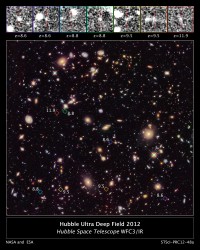
University of Edinburgh astronomers have used the NASA/ESA Hubble Space Telescope to reveal a population of primitive galaxies that formed more than 13 billion years ago, when the Universe was less than 4% of its present age. One of these is probably the most distant galaxy found to date (at redshift 12). These new observations shed new light on the earliest years of cosmic history.
A team of scientists, led by Edinburgh astronomers Ross McLure and Jim Dunlop in collaboration with Richard Ellis at Caltech, have used the Hubble Space Telescope to make new observations of a tiny patch of sky called the Hubble Ultra Deep Field (HUDF), as part of a project to improve our understanding of the early years of the Universe. The resulting images offer the deepest ever view of the Universe. Although taken at near-infrared wavelengths, the images capture ultraviolet light emitted by the most distant galaxies, which has been “redshifted” to infrared wavelengths by the expansion of the Universe. Because light takes so long to travel from these remote objects, the astronomers are effectively looking back in time, and see these young galaxies as they appeared less than 600 million years after the Big Bang.
Previously unknown galaxies
The new data have allowed the team to uncover six previously unknown galaxies in this era and to rule out a number of tentative identifications of distant galaxies made by other scientists in previous research. This is the first reliable census of galaxies at such an early time in cosmic history, and shows that the number of galaxies steadily increased with time. This supports the idea that the first galaxies did not form in a sudden burst, but gradually assembled their stars, causing the Universe to slowly emerge from darkness into “cosmic dawn”.
One previously-claimed extreme redshift galaxy in the Hubble Ultra Deep Field has survived the scrutiny of the Edinburgh-USA team. This is UDFj-39546284, for a while claimed to be the most distant known galaxy, at redshift 10. However, the improved and extended dataset has allowed the scientists to show that it either lies at an even greater distance than previously thought (at a redshift of 12), or must be a hitherto undiscovered type of extreme emission-line galaxy at much lower redshift.
“Our study has taken the subject forward in two ways,” says Ellis. “First, we have used Hubble to make longer exposures than before. The added depth is essential to reliably probe the early period of cosmic history. Second, we have used Hubble’s available colour filters very effectively to measure galaxy distances more precisely.”
Studying galaxies in the early years of the Universe is fraught with difficulties. Scientists are working at the very limits of Hubble’s capabilities, and some previous claims of very distant galaxies have had to be revised in the light of improved observations. The scientists thus placed special emphasis on obtaining data of the quality necessary to provide robust identifications of galaxies at redshifts greater than 8. Part of this involves taking additional data through filters which have already been used to take deep images of the Hubble Ultra Deep Field, but the team has also added new imaging through previously unexploited filters. “We added an additional filter, and undertook much deeper exposures in some filters than in earlier work in order to convincingly reject the possibility that some of our galaxies might be foreground objects,” said James Dunlop of the Institute for Astronomy, University of Edinburgh.
UDF12 project
The observations, part of a project called UDF12, were made over a period of six weeks during August and September 2012, and the first results are now appearing in a series of scientific papers.The UDF12 team has now released the final images for public use, after preparing them for ease of exploitation by other research groups.
A major goal of the new program was to determine how rapidly the number of galaxies increased over time in the early Universe. This measure is the key evidence for how quickly galaxies build up their constituent stars.
“This discovery of a significant population of galaxies at redshifts greater than 8, coupled with our new analysis of the number and properties of galaxies at redshift 7 and 8, support the idea that galaxies assembled progressively over time,” said the project co-PI Dr. Ross McLure from the Institute for Astronomy, University of Edinburgh.
The results from the UDF12 campaign suggest there will be many undiscovered galaxies even deeper in space waiting to be revealed by the James Webb Space Telescope, which will be launched in 2018.
The team’s new distant galaxy census, including the new candidate for the most distant object ever seen, has been accepted for publication in the Astrophysical Journal Letters. The paper is entitled: The abundance of star-forming galaxies in the redshift range 8.5 to 12: new results from the 2012 Hubble Ultra Deep Field campaign.
Images
Figure 1: A new robust sample of the most distant galaxies
This new image of the Hubble Ultra Deep Field (HUDF) reveals seven newly discovered distant galaxies, which are seen as they appeared in a period 350 million to 600 million years after the Big Bang. The galaxy census, the result of a program called `HUDF 2012’, provides the most robust sample of galaxies ever found at these early epochs. One of the galaxies may be a distance record breaker, observed only 380 million years after the birth of our universe. All were detected in near-infrared light using Hubble’s Wide Field Camera 3.
The coloured squares in the main image indicate the locations of these most distant galaxies within the Hubble Ultra Deep Field, while the boxes at the top show zoomed-in black-and-white images centred on each object. The “redshift” of each galaxy is indicated beside each box, denoted by the symbol “z”. Redshift measures how much a galaxy’s ultraviolet and visible light has been stretched to infrared wavelengths by the expansion of the Universe. The larger the redshift, the more distant the galaxy, and hence (due to the finite speed of light) the further we are seeing back in time. The most distant galaxy of these seven is the most remote object discovered to date, at redshift 11.9. This means we view it only 380 million years after the Big Bang, when the Universe was less than 3% of its present age.
The HUDF12 observations were taken in August and September 2012.
Credit: NASA, ESA, R. Ellis (California Institute of Technology, Pasadena, Calif.), J. Dunlop and Ross McLure (Institute for Astronomy, University of Edinburgh), B. Robertson (University of Arizona, Tucson), and A. Koekemoer (Space Telescope Science Institute, Baltimore, Md.).
Figure 2: UDF 12 Cosmic History
A schematic representation of the history of the Universe, highlighting the key epoch of "cosmic dawn" probed by the new 2012 Hubble Space Telescope observations. The Big Bang is on the left, with the present day on the right. Lookback time is indicated on the bottom, with redshift on the top. The space observatories shown in the picture are the Hubble Space Telescope on the right, and its successor the James Webb Space Telescope on the left, which is expected to launched in 2018 and will open up the study of galaxies beyond a redshift of 12.
Figure 3: Discovering the most distant galaxies with Hubble
This graphic illustrates the technique used by astronomers to discover the most distant galaxies with Hubble. The coloured shapes indicate the different wavebands of light that are detected in the images taken by Hubble through different filters. The blue-green filters on the left allow regions of normal optical light to pass through to Hubble’s optical camera (the Advanced Camera for Surveys; ACS), while the redder filters to the right allow infrared light through to be detected by the newer infrared-sensitive camera Wide Field Camera 3 (WFC3) which was installed in Hubble during the last shuttle servicing mission in 2009. By imaging the same patch of sky through these different filters, astronomers can establish the spectral shape of the light from different objects in the field-of-view.
The white curve then shows the distinctive shape anticipated from a very high-redshift galaxy, which shows a sharp step at ultraviolet wavelengths due to foreground absorption by neutral hydrogen gas in the young Universe. This sharp step is redshifted all the way from the ultraviolet to infrared wavelengths by redshifts greater than 7, and here its progressive movement to ever redder wavelengths is shown at redshifts of z = 8, 10 and 12. Objects like this are therefore detected in the red bands but disappear when imaged through the bluer filters. The lowest plot shows why Hubble cannot see objects at all much beyond z ~ 12.
Credit: NASA, ESA.
Papers
Ellis et al. 2012: http://adsabs.harvard.edu/abs/2012arXiv1211.6804E
Dunlop et al. 2012: http://adsabs.harvard.edu/abs/2012arXiv1212.0860D
Koekemoer et al 2012: http://adsabs.harvard.edu/abs/2012arXiv1212.1448K
Image gallery
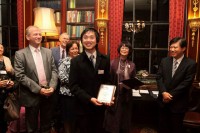
Congratulations to all our students who received medals and certificates in recognition of outstanding marks achieved during the 2011/12 academic year.
University awards
- Certificates of Merit were given to 44 students from years 1 and 2 to recognise their achievement in Physics and Maths courses.
- Class Medals were awarded to the Honours students with the highest overall mark for their degree programme, and to the Pre-Honours students with the highest marks in core and programme-related courses.
- The Tait Medal and Robert Schlapp Prize is awarded to the student with the highest marks in Mathematical Physics. This year, it was decided to give this award to two equally exceptional students: Alastair Heffernan and Vladimir Prochazka.
The awards ceremony took place at the University's Playfair Library on 14 November 2012.
Anglo Thai-Society Academic Excellence Award
Wanaruk Chaimayo received the Anglo Thai-Society Academic Excellence Award 2012. He was presented with an engraved plaque and a cheque by the Ambassador of Thailand at a ceremony in the Oriental Club, London.
The Annual Awards are for Thai students in the final stages of their PHD research in the UK who have a record of outstanding performance during their time of study here. Wanaruk's PhD thesis is entitled 'Synthesis and high pressure structural studies of bismuth nanoparticles'.
Image gallery

The short-lived isotope 18F is of particular interest because its decay - if observed by satellite missions - could provide important clues to nucleosynthesis (the process of creating new atomic nuclei from pre-existing nucleons) taking place in novae explosions. A study published in Physical Review Letters puts firmer constraints on the amount of 18F that can be produced in classical novae, the class of novae which have been seen to erupt only once.
Classical novae occur frequently within our galaxy and have been proposed as a key source of certain rare isotopes such as 18F and also 13C, 15N, 17,18O and19F. The 17O(p,γ)18F reaction governs the production of 18F, so an accurate determination of its rate in the energy region relevant for classical novae is crucial.
The reaction has been studied at the Laboratory for Underground Nuclear Astrophysics (LUNA), located under the Gran Sasso massif in Italy. Here, a team of international scientists, including members of the Edinburgh Nuclear Physics group, has measured the reaction cross section to the lowest energies to date. The unique underground location provides an extremely quiet environment almost void of cosmic background, and allows for an improved signal-to-noise ratio and unprecedented sensitivity.
The reaction rate has been determined with a four-fold improved precision. This puts firmer constraints on current models of novae explosions and provides a better understating of the role played by this important reaction.
The study [1] forms part of the PhD work of the paper’s first author, Mr David Scott (supervisors: Dr Marialuisa Aliotta and Dr Thomas Davinson). It appears in the Editors’ Suggestions of the latest issue of Physical Review Letters.
[1] D.A. Scott et al. Phys. Rev. Lett. 109, 202501 (2012) - Published Tue Nov 13, 2012
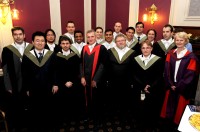
The School of Physics & Astronomy offers up to two Master's scholarships in High Performance Computing (HPC) for the 2013-2014 academic session. Each scholarship covers tuition fees and additional programme costs and is tenable for one academic year. These scholarships are awarded competitively.
MSc in High Performance Computing
The MSc in HPC is taught by EPCC, a research institute within the School. EPCC is one of the leading supercomputing centres in Europe, and manages an extensive collection of HPC systems including HECToR, the UK’s £115 million national supercomputing service. HECToR, a 44,000-processor Cray XE6 system, is one of the UK's largest, fastest and most powerful supercomputers. Students taking the MSc learn the fundamental techniques required to program such large machines, and have access to leading-edge HPC platforms and technologies for their research projects.
Eligibility
UK/EU students who have been accepted for admission to the MSc in High Performance Computing at the University of Edinburgh are eligible to apply.
Applicants must have, or expect to obtain, a UK first class or 2:1 Honours degree or its equivalent from outside the UK.
Applying
Please indicate whether you would like to be considered for a School of Physics & Astronomy UK/EU Master's Scholarship in High Performance Computing in your online application form.
The closing date for applications is Monday April 1st 2013.
Successful applicants will be notified by Friday May 3rd 2013.
Further information
For more information, please msc [at] epcc.ed.ac.uk (contact the Programme Administrator)
Come to the Open Day to find out more!
Why not visit us on the next Post-Graduate Open Day on November 23rd? You'll meet staff and current students and find out what the MSc in HPC can offer you. Register here.
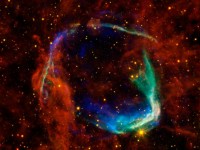
While parts of the world experience economic hardship, a team of astronomers co-led by Professsor Philip Best at the Institute for Astronomy in Edinburgh has found an even bigger slump happening on a cosmic scale.
In the largest ever study of its kind, the international team has established that the rate of formation of new stars in the Universe is now only 1/30th of its peak and that this decline is only set to continue. The results were published today in the journal Monthly Notices of the Royal Astronomical Society.
Recycling stars
The accepted model for the evolution of the Universe suggests that stars began to form about 13.4 billion years ago, or around three hundred million years after the Big Bang. Many of these first stars are thought to have been monsters by today's standards, and were probably hundreds of times more massive than our Sun. Such beasts aged very quickly, exhausted their fuel, and exploded as supernovae within a million years or so. Lower mass stars in contrast have much longer lives and last for billions of years.
Much of the dust and gas from stellar explosions was (and is still) recycled to form newer and newer generations of stars. Our Sun, for example, is thought to be a third generation star, and has a very typical mass by today's standards. But regardless of their mass and properties, stars are key ingredients of galaxies like our own Milky Way. Unveiling the history of star formation across cosmic time is fundamental to understanding how galaxies form and evolve.
In the new study, the scientists used the UK Infrared Telescope (UKIRT), the Very Large Telescope (VLT) and the Subaru telescope to carry out the most complete survey ever made of star-forming galaxies at different distances, with around ten times the data of any previous effort. With the range of distances, the time taken for the light to reach us means that we see identically-selected galaxies at different periods in the history of the universe, so we can really understand how conditions change over time.
"You might say that the Universe has been suffering from a long, serious 'crisis': cosmic GDP output is now only 3% of what it used to be at the peak in star production! The future may seem rather dark, but we're actually quite lucky to be living in a healthy, star-forming galaxy which is going to be a strong contributor to the new stars that will form." David Sobral, former PhD student at the Institute for Astronomy, who led the paper.
By looking at the light from clouds of gas and dust in these galaxies where stars are forming, the team were able to assess the rate at which stars are being born. They find that the production of stars in the Universe as a whole has been continuously declining over the last 11 billion years. Half of the stars in the Universe were born in the 'boom' that took place between 11 and 9 billion years ago and it took more than five times as long to produce the rest. If the measured decline continues, then no more than 5% more stars will form over the remaining history of the cosmos, even if we wait forever.
Professor Best added "While these measurements provide a sharp picture of the decline of star-formation in the Universe, they also provide ideal samples to unveil the even more fundamental mystery which we are continuing to work to solve: why?"
Image gallery
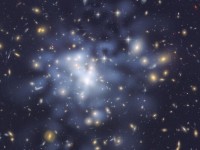
People around the world are invited to help solve one of the Universe's enduring mysteries.
Astronomers from the School of Physics & Astronomy have launched a public competition to help them learn more about dark matter, which accounts for 95 per cent of the mass of the Universe but cannot be seen and is little understood.
The researchers have joined forces with crowdsourcing data science website Kaggle and Winton Capital Management to find people who are interested in taking up the challenge. It is hoped the contest will inspire thousands of people to tackle the problem, using a variety of techniques.
The competition is expected to attract people who solve numerical problems for a living, such as scientists, statisticians and data engineers, who may find a solution by adapting an existing problem-solving tool from a field of expertise outside astronomy.
"By encouraging thousands of people to focus on a problem, we have a good chance of making progress quickly. This competition could make a real difference in solving an enigma that has puzzled astronomers for decades." David Harvey, School of Physics & Astronomy, University of Edinburgh
Dr Tom Kitching, of the University's School of Physics & Astronomy, said: “This kick-starts a new way for cutting edge science to interact with the private sector. Scientists have problems that need solving, data scientists world-wide are searching for interesting problems and exciting career opportunities. By working together it’s a win-win situation: the problem of solving dark matter gets a boost, the competition winners receive a prize.”
Prizes of US$12,000, US$5,000 and US$3,000 are being provided by Winton, which uses similar data science techniques to build automated trading systems for financial markets.
Mapping dark matter
Dark matter is known to cause galaxies to form clusters in space. Scientists want to develop ways to analyse images of these galaxy clusters, taken by the Hubble telescope. This will enable them to better understand how the clusters have formed, and create a map of dark matter, giving insight into its make-up.
The Observing Dark Worlds competition can be found at http://www.kaggle.com/c/DarkWorlds
Entrants have until 16 December to submit their ideas.
Image gallery
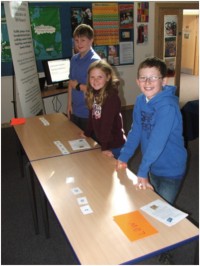
Mario Antonioletti and Iain Bethune of EPCC write here about EPCC's participation in two science festivals.
We demonstrated the power and utility of supercomputers at the British Science Festival in Aberdeen and Bang Goes The Borders in Melrose. At both events the audience showed a high level of interest in finding out what supercomputing is all about.
Our goal was to encourage the general public to interact directly with a supercomputer. We already had the supercomputer – HECToR, the UK's national supercomputing service – but we needed an application.
Visual Molecular Dynamics (VMD) is an application that allows systems to be visualized while being simulated by an underlying code. We chose NAMD2 to run the simulation as it is a supported application on HECToR and is well integrated with VMD. Not only does VMD let you visualize a system as it runs – including zooming, rotating and panning - but it also allows external forces to be applied to an atom or molecule. These are fed back into the simulation in real time.
Scientific simulation
Now we required an interesting simulation to tell a compelling story.
Professor Charles Laughton (University of Nottingham) has studied the thermodynamics of ligand binding using the mouse major urinary protein3. The simulation itself is simply a protein embedded in a water molecule. Inside the protein is a pheromone molecule – the protein acts as a slow release for any of the more volatile pheromone particles that may be trapped inside.
Using NAMD to model the system and VMD to visualise it, we created a demo where the audience could apply external forces to try to pull the pheromone out of the protein.
Thanks to Cray, we had a Cray XT4 blade to show alongside the demo. This is the type used in HECToR and it was a big crowd pleaser!
Demonstrating parallel algorithms
We also wanted to convey how a task could be performed faster by following a parallel algorithm (this is the set of steps required to solve a specific problem using several computer processors or cores working at the same time).
We printed cards numbered 1–60, shuffled a subset of them and asked a willing volunteer to sort them. Invariably this took too long, so we stopped this early having demonstrated the point. We then got several members of the audience to act as computer cores. They were each given a subset of cards which they sorted by swapping highest and lowest numbers, until all the highest cards were at one end of the line and all the lowest were at the other.
Having played the part of a supercomputer, the audience moved on to trying to pull the pheromone out of the mouse protein, with the demo running on 256 cores remotely on HECToR while being displayed locally using VMD at Aberdeen. So not only did our audience get to play the part of a supercomputer, they also got to play with the real thing!
We also took our demo to Melrose’s “Bang Goes The Borders” festival, which offers children a chance to experience science from laser physics to zombies – and now supercomputers too.
Image gallery

Prospective postgraduate students are warmly invited to visit the School of Physics & Astronomy during the next Open Day on Friday 23rd November.
PhD studies in Physics and Astronomy
If you have, or are likely to graduate with, a 2.1 or first-class degree in Physics or Astronomy, why not consider taking doctoral studies in this School?
The Postgraduate Open Day offers a unique opportunity to hear about the PhD programmes and projects that we offer, and for students to discuss prospective studies with academic staff. Current students will be there to tell you what it is like, and there will be tours of the building with staff on hand to explain experimental work. Last but least, information on funding will be available, for there are scholarships to cover tuition fees and living expenses. Informal one-to-one interviews may also be possible, depending on the availability of academic staff.
Please see our timetable for the day here: /studying/postgraduate-research/postgraduate-open-day
The MSc in High Performance Computing
The MSc in High Performance Computing (HPC) provides an excellent grounding in HPC technologies and their practical application. It will appeal if you have a keen interest in programming and would like to learn about HPC and parallel programming.
The MSc provides a doorway to a wide range of careers, including computational science research and commercial software development. Current students are welcome to join the Postgraduate Open Day to meet staff and current students and learn about what the MSc and the University have to offer.
Registration is required. See link below.
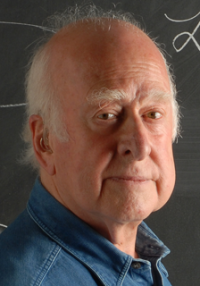
Professor Peter Higgs has been presented with a specially-commissioned medal in recognition of his outstanding work, which led to the discovery of a Higgs-like boson.
“Professor Higgs’ achievements have shaped Man’s understanding of Nature at the most fundamental level.” Professor Sir John Arbuthnott, President of the Royal Society of Edinburgh
Read the full story on the RSE's website.
Image gallery

Andy Buckley and Jennifer Smillie, two researchers in the School's Institute for Particle and Nuclear Physics, have been appointed Royal Society University Research Fellows. The Fellowship scheme aims to give outstanding scientists, who have the potential to become leaders in their chosen fields, the opportunity to build an independent research career.
"This fellowship is a wonderful award. It will allow me to focus on a long-term research programme into the fascinating area where the physics of the Higgs boson and the strong force meet. I'm thoroughly looking forward to the work, and the additional opportunities that association with the Royal Society has to offer." Dr Andy Buckley, Particle Physics Experiment, School of Physics & Astronomy
"I was delighted to be awarded this fellowship. It will allow me to focus on my own programme of research for the next five years. With the recent discovery of the Higgs boson, this is a pivotal time for particle physics and I'm really looking forward to making my contribution to the next developments." Dr Jenni Smillie, Particle Physics Theory, School of Physics & Astronomy
Two other University researchers - Sarah Reece and Gerben van Ooijen, both Biological Sciences - were also chosen.

